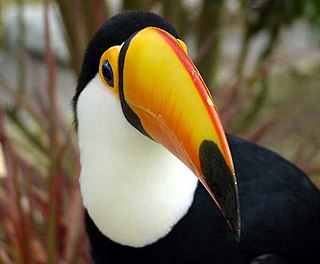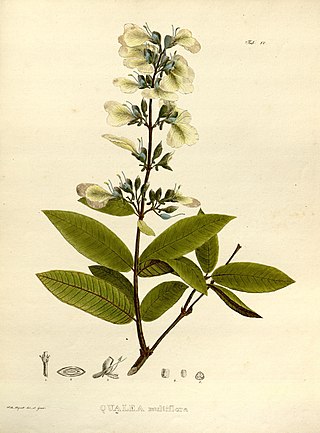Related Research Articles

The Cerrado is a vast ecoregion of tropical savanna in eastern Brazil, being present in the states of Goiás, Mato Grosso do Sul, Mato Grosso, Tocantins, Maranhão, Piauí, Bahia, Minas Gerais, São Paulo, Paraná and the Federal District. The core areas of the Cerrado biome are the Brazilian highlands – the Planalto. The main habitat types of the Cerrado consist of forest savanna, wooded savanna, park savanna and gramineous-woody savanna. The Cerrado also includes savanna wetlands and gallery forests.
Dianthera angustifolia is a species of flowering plant native to the Cerrado ecoregion of central Brazil.
Justicia burchellii is a species of flowering plant native to the Cerrado ecoregion of central Brazil.
Justicia chrysotrichoma is a species of flowering plant in the family Acanthaceae. It is native to the Cerrado ecoregion of central Brazil.
Justicia riparia is a species of flowering plant. It is endemic to southeastern Brazil, where it is native to the Cerrado vegetation.
Justicia sarothroides is a species of flowering plant native to the Cerrado ecoregion of west-central Brazil.
Justicia warmingii is a species of flowering plant. It is native to Bolivia, southeastern and west-central Brazil, Paraguay, northwestern Argentina, and Peru. In Brazil it grows in the Cerrado ecoregion.
Dicliptera mucronifolia is a species of flowering plant in the acanthus family, Acanthaceae. it is a subshrub native to eastern, southern, and west-central Brazil, where it grows in the Cerrado ecoregion. This plant is cited in Flora Brasiliensis by Carl Friedrich Philipp von Martius.
Ruellia verbasciformis is a species of flowering plant native to the Cerrado vegetation of Brazil. It is endemic to west-central Brazil. This plant is cited in Flora Brasiliensis by Carl Friedrich Philipp von Martius.
Ruellia densa is a species of flowering plant in the family Acanthaceae. It is a native to the Cerrado region of central Brazil.
Justicia tocantina is a species of perennial flowering plant native to Bolivia, west-central and southeastern Brazil, and Paraguay, including the Cerrado ecoregion of Brazil. This plant is cited in Flora Brasiliensis by Carl Friedrich Philipp von Martius.

The wildlife of Brazil comprises all naturally occurring animals, plants, and fungi in the South American country. Home to 60% of the Amazon Rainforest, which accounts for approximately one-tenth of all species in the world, Brazil is considered to have the greatest biodiversity of any country on the planet. It has the most known species of plants (60,000), freshwater fish (3,000), amphibians (1,188), snakes (430), insects (90,000) and mammals (775) It also ranks third on the list of countries with the most bird species (1,971) and the third with the most reptile species (848). The number of fungal species is unknown. Approximately two-thirds of all species worldwide are found in tropical areas, often coinciding with developing countries such as Brazil. Brazil is second only to Indonesia as the country with the most endemic species.
Ruellia brevicaulis is a species of flowering plant native to Argentina, Brazil, and Paraguay. It is native to the Cerrado vegetation of Brazil.
Ruellia trachyphylla is a species of flowering plant native to the Cerrado ecoregion in west-central Brazil.
Ruellia dissitifolia is a species of flowering plant in the family Acanthaceae. It is native to the Cerrado ecoregion of Brazil.
Staurogyne hirsuta is a species of plant native to Brazilian cerrado vegetation. It is a subshrub endemic to Minas Gerais state in southeastern Brazil. This plant is cited in Flora Brasiliensis by Carl Friedrich Philipp von Martius.

Apeiba tibourbou is a tree native to Caatinga and Cerrado vegetation in Brazil, and Costa Rica. It is used as an alternative fiber crop to make paper. It is found in Mexico, Central America, and the northern part of South America.

Hebanthe erianthos, known as suma or Brazilian ginseng, is a species of plant in the family Amaranthaceae. The specific epithet is also spelt "eriantha", although the basionym is Iresine erianthos.

Qualea multiflora is a species of tree in the family Vochysiaceae.

Campomanesia guazumifolia is a species of tree in the family Myrtaceae.
References
- 1 2 "Tyloglossa genistiformis Nees". Plants of the World Online . Royal Botanic Gardens, Kew . Retrieved 2 October 2024.